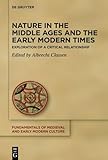Nature in the Middle Ages and the Early Modern Times : Exploration of a Critical Relationship / ed. by Albrecht Classen.
Material type: TextSeries: Fundamentals of Medieval and Early Modern Culture ; 29Publisher: Berlin ; Boston : De Gruyter, [2024]Copyright date: 2024Description: 1 online resource (VIII, 597 p.)Content type:
TextSeries: Fundamentals of Medieval and Early Modern Culture ; 29Publisher: Berlin ; Boston : De Gruyter, [2024]Copyright date: 2024Description: 1 online resource (VIII, 597 p.)Content type: - 9783111387239
- 9783111387826
- 9783111387635
- 800
- online - DeGruyter
- Issued also in print.
| Item type | Current library | Call number | URL | Status | Notes | Barcode | |
|---|---|---|---|---|---|---|---|
 eBook
eBook
|
Biblioteca "Angelicum" Pont. Univ. S.Tommaso d'Aquino Nuvola online | online - DeGruyter (Browse shelf(Opens below)) | Online access | Not for loan (Accesso limitato) | Accesso per gli utenti autorizzati / Access for authorized users | (dgr)9783111387635 |
Frontmatter -- Contents -- Introduction -- Nature and Human Society in the Pre-Modern World -- Unnatural Humans: The Misbegotten Monsters of Beowulf -- Natural Environment in the Old English Orosius: Ohthere’s Travel Accounts in Norway -- When Is a Good Time? Health Advice and the Months of the Year -- Humans Serving Nature: Beekeeping and Bee Products in Piero de Crescenzi’s Ruralia commoda -- Medieval Epistemology and the Perception of Nature: From the Physiologus to John of Garland and the Niederrheinische Orientbericht. Bestiaries and the ‘Book of Nature’ -- Waste, Excess, and Profligacy as Critiques of Authority in Fourteenth-Century English Literature -- “A New Flood Was Released from the Heavens”: The Literary Responses to the Disaster of 1333 -- The Environmental Causes of the Plague and their Terminology in the German Pestbücher of the Fourteenth and Fifteenth Centuries -- Island, Grove, Bark, and Pith: Nature Metaphors in Teresa de Cartagena -- Nature, Art, and Human Perception in Giulio Romano’s Room of the Giants at the Palazzo del Te, Mantua (1532–1535) -- Human Body, Natural Causes, and Aging of the World in Czech-Language Sources of the Late Middle Ages and Early Modern Period -- Perception of Air Quality in the Czech Lands of the Sixteenth and Seventeenth Centuries -- Johann Arndt’s Book of Nature: Medieval Ideas During the German Reformation -- Imitation vs. Allegorization: Martin Opitz’s Influential Proposal Concerning Poetic Reflections on Nature -- François Bernier and Nature in Kashmir: Belonging in Paradise? -- Cosmology and Pre-Modern Anthropology -- Praising Perchta as the Embodiment of Nature’s Cycles: Worship and Demonization of Perchta and Holda in Medieval and Early Modern Culture -- List of Illustrations -- Biographies of the Contributors -- Index
restricted access online access with authorization star
http://purl.org/coar/access_right/c_16ec
The study of pre-modern anthropology requires the close examination of the relationship between nature and human society, which has been both precarious and threatening as well as productive, soothing, inviting, and pleasurable. Much depends on the specific circumstances, as the works by philosophers, theologians, poets, artists, and medical practitioners have regularly demonstrated. It would not be good enough, as previous scholarship has commonly done, to examine simply what the various writers or artists had to say about nature. While modern scientists consider just the hard-core data of the objective world, cultural historians and literary scholars endeavor to comprehend the deeper meaning of the concept of nature presented by countless writers and artists. Only when we have a good grasp of the interactions between people and their natural environment, are we in a position to identify and interpret mental structures, social and economic relationships, medical and scientific concepts of human health, and the messages about all existence as depicted in major art works. In light of the current conditions threatening to bring upon us a global crisis, it matters centrally to take into consideration pre-modern discourses on nature and its enormous powers to understand the topoi and tropes determining the concepts through which we perceive nature. Nature thus proves to be a force far beyond all human comprehensibility, being both material and spiritual depending on our critical approaches.
Issued also in print.
Mode of access: Internet via World Wide Web.
In English.
Description based on online resource; title from PDF title page (publisher's Web site, viewed 20. Nov 2024)


